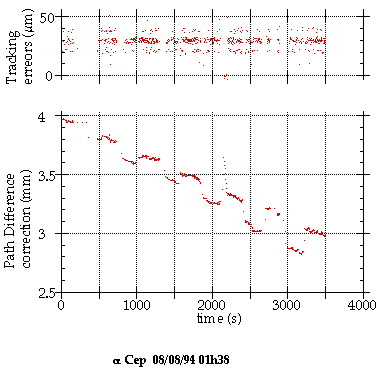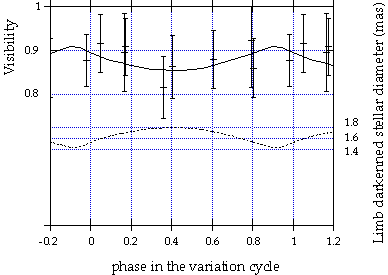Aperture Synthesis and fringe tracking at GI2T
:
In order to get interferometric data that allows the observation at
milli-arc second resolutions, one needs to maintain the coherence of the
beams from each telescope. That means maintaining the optical paths dynamically
equal within a few micrometers for baselines up to 50 meters or more. The
coarse part of the correction is done by an "earth rotation compensation"
displacement induced to a delay line. The rest is achieved by analyzing
the light in the recombined beam and correcting the optical paths errors
in real time. The loop period is presently a few seconds, although short
frame tines are used in image acquisition by a photon counting camera.
The correction is slow because there are only a few thousand photons per
second passing through our narrow spectral band pass : 128 channels, 0,4
nm each. The following graph shows tracking data.

see reference : L. Koechlin, P. R. Lawson, D. Mourard, A.Blazit, D.
Bonneau, F.Morand, Ph. Stee, I.Tallon-Bosc, F.Vakili, "Dispersed fringe
tracking with the multi-ro apertures of the Grand Interféromètre
à 2 Télescopes" L. , Appl. Opt. 35, 3002--3009 (1996).
Optical Interferometry already gave access to many parameters which
allowed to refine stellar atmosphere models and to the measurement stellar
masses masses and stellar distances.
One example : measurement of the diameter variations of Delta Cephei:

see reference : D. Mourard, D. Bonneau, L. Koechlin, A. Labeyrie, F.
Morand, Ph. Stee, I. Tallon-Bosc, F. Vakili: "The mean angular diameter
of d Cephei".. Astronomy & Astrophysics 317, 789 (1996).